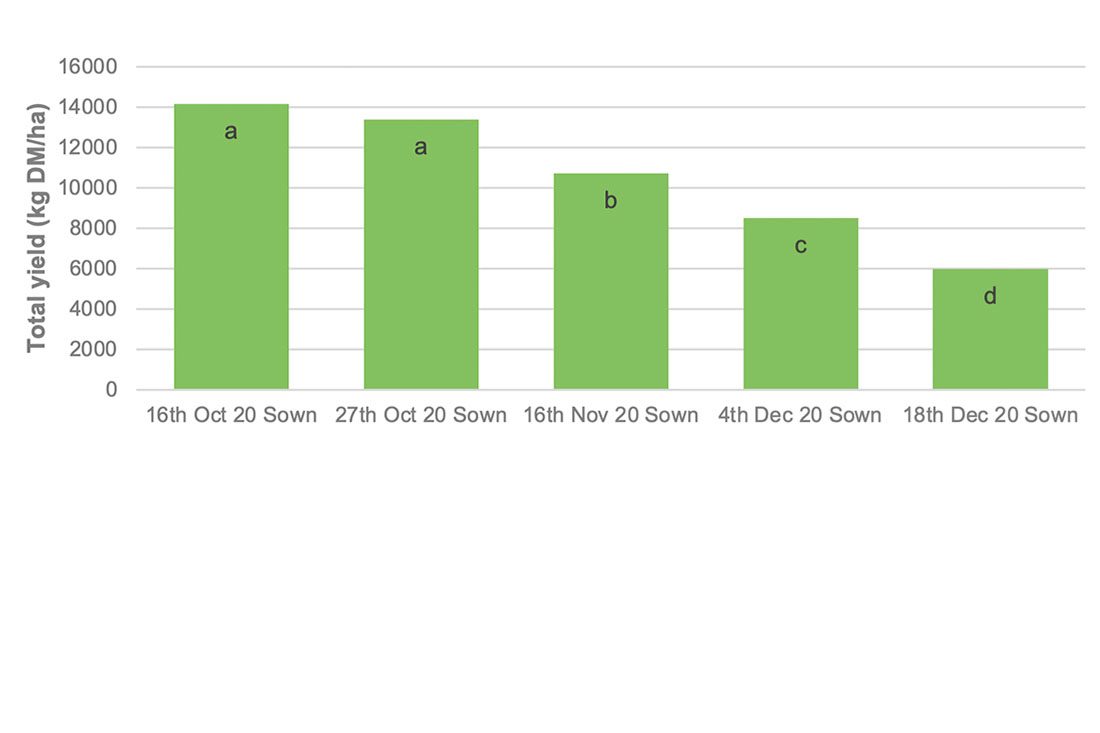Agricom research site trial - Total accumulated yield (kg DM/ha) until the end of April 2021, from five sowing dates between 16 October 2020 and 18 December 2020, for Choice chicory in the Waikato.
With cost of production pressures combined with an emphasis on emissions reductions, Choice chicory presents an excellent solution for maintaining or improving milk production over the coming season while reducing reliance on imported feed.
Choice chicory has been used by many New Zealand farmers for over a decade and has consistently proven its reliability and performance.
Choice chicory has the ability to produce up to 16 tonnes of DM/ha between September and May1, offering some of the most cost effective, high quality feed during this period.
To achieve this level of productivity, several agronomic considerations are crucial, including seedbed preparation, timing of sowing, weed control and timing of the first grazing, among others.
The figure below shows the importance of sowing date on maximising the yield potential of Choice chicory. Generally, the ideal sowing timing is when soil temps have reached 12°C and are consistently rising.
Chicory is a herb with a deep taproot capable of providing high volumes of very high quality forage through the summer and autumn months. Choice is an excellent option as a six to eight month multi-graze summer crop to supplement milking cows when ryegrass growth rates and quality are poor. Choice has been thoroughly proven on farms and in research to substantially increase milksolids production in dairy systems across New Zealand.
Nutritional advantages
Chicory is rich in essential nutrients such as protein, minerals, and vitamins, making it a highly nutritious feed option. Its high energy content supports lactation in dairy cows, contributing to improved milk production and overall herd health2.
Adaptability and resilience
Choice chicory’s deep root system allows it to access water and nutrients from deeper soil layers, making it resilient to drought conditions. This adaptability ensures a consistent feed supply, even in adverse weather, reducing the need for external feed inputs.
Cost effectiveness
Replacing a portion of imported feed with home grown chicory enables dairy farmers to significantly reduce feed costs and potential to reduce emissions.
Establishment and management
To maximise the benefits of chicory, effective management is essential. This includes correct sowing techniques, rotational grazing practices, and ensuring that chicory is well-integrated with other pasture species to maintain a balanced diet for livestock.
Return on investment
While the initial establishment of chicory may involve costs, the long-term savings from reduced feed imports and lower input requirements make it an economically viable option. Integrating Choice chicory into dairy farming systems presents a compelling opportunity to reduce costs, lower on-farm emissions, and enhance the sustainability of dairy production.

As the dairy industry faces increasing pressure to adopt environmentally friendly practices, homegrown Choice chicory offers a practical solution that aligns with both economic and environmental objectives.
Contact your local TSR for more information on how you can implement Choice chicory in your farming system this coming season.
1 Lee and Minnee. (2012). DairyNZ Technical Series, August 2012. Chicory and plantain – your questions answered.
2 DairyNZ, 2023. Chicory – DairyNZ; [accessed 2024 September 12]. www.dairynz.co.nz/feed/crops/chicory/.
Article supplied by Agricom